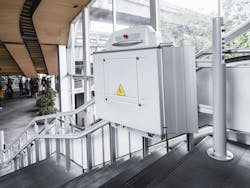As an electrical apprentice, to advance your basic knowledge of the National Electrical Code (NEC), I’ve always found it’s best to word-associate the purpose of each Chapter. This handy trick will help you efficiently identify the installation guidelines you seek much faster. In the process, you’ll also impress the boss, gain respect from your peers and journeymen, and help you build trust in others that depend on you.
When you think about Chapter 6, the first word that comes to mind is special. The Articles found within this Chapter contain diverse, unique, or complex equipment system requirements that may require specialized training. Here are just a few examples:
- Art. 605 (Office Furnishings)
- Art. 669 (Electroplating)
- Art. 660 (X-Ray Equipment)
- Art. 670 (Industrial Machinery)
- Art. 692 (Fuel Cell Systems)
- Art. 695 (Fire Pumps)
In addition, the wiring methods for the equipment included in these Articles may modify requirements from Chapter 3. They supplement or amend the basics you learned in Chapters 1-4 (Figure 90.3), so be prepared to meet additional guidelines. That means don’t make assumptions. Installation errors of the equipment found in these Articles can cause severe injury or death to the installer and user of this equipment. Additional measures and accuracy must be taken by electricians performing these Chapter 6 installations to avoid equipment failures, ensure safety for users and consumers, and prevent voiding any equipment manufacturers’ warranties.
Seek help on special installations
Chapter 6 is the second of four chapters that focuses specifically on specialized (non-typical) areas of work for electricians. Due to the technical nature and liability associated with these installations, some electricians choose to specialize, making them experts in these niches. However, this requires in-depth knowledge of other parts of the Code as well.
For example, Art. 680 (Swimming Pools, Fountains, and Similar Installations) requires a significant understanding of Art. 240 (Overcurrent Protection), Art. 250 (Grounding and Bonding), and Art. 430 (Motors, Motor Circuits, and Controllers). Permanent pool installations require specific wiring methods, burial depths for raceways, and specific locations for receptacles and electrical equipment systems.
Electrical shock drowning, for example, can occur when lighting systems and grounding/bonding systems are improperly installed or maintained around pool areas. So be prepared to do in-depth research before starting these installations or providing repair services.
Emerging industries require more training
Article 690 (Solar Photovoltaic Systems) has provisions that require installers to have a basic understanding in inverters, direct current, charge controllers, alternating current, and storage battery systems.
As you can see, the Articles in Chapters 6-8 are more complicated in nature and structure. Figure 690.1 (B) identifies solar photovoltaic system components; this handy chart provides insight into designs and layouts for common array systems and their components. Solar or PV systems installers must be very knowledgeable of the required disconnecting means (e.g., types and locations) for individual panels and conductors throughout the system in Sec. 690.13.
Keep in mind the equipment and systems found in Chapter 6 (and their associated parts) may require you to meet additional guidelines outside of the NEC, such as those set forth by third-party organizations such as Underwriters Laboratories or Nationally Recognized Testing Laboratory.
No one has ‘done it all’
Remember, all electricians aren’t created or trained equally; no one has done it all! Anyone claiming to have done it all in this vast industry isn’t being truthful. How many electricians have you met that install or repair pipe organs found in Art. 650, electrically driven or controlled irrigation machines (Art. 675), or cranes and hoists (Art. 610)? I’m guessing probably not an overwhelming amount. So always remember the special equipment found in these Articles may require additional safety protocols and measures when installing, repairing, or modifying any of their related systems, functions, and operation.
Follow my column for more practical how-to articles and tips for applying electric basics concepts in the field (Everyday Instructions for Electricians, Introduction to Commercial Service Calculations, Introduction to Residential Service Calculations, The Apprentice’s Guide to Non-Metallic Sheathed Cable, The Apprentice’s Guide to NEC Chapter 4, The Apprentice’s Guide to Art. 300, and the Apprentice’s Guide to Art. 640. For more information on why a structured approach is so important to navigating the NEC and how to put its requirements into practice in real-world settings, read “The NEC for Newbies.”
Harold De Loach, a master electrician and electrical trainer/instructor, is the founder of The Academy of Industrial Arts (www.taia-school.com) in Philadelphia. With more than 30 years of experience in the field, he writes regular exclusive content for the E-Train and can be reached at [email protected].
About the Author
Harold De Loach
De Loach is the Director of Education and Training for the Leaders of Electrical License Preparation courses for Philadelphia and The Lehigh Valley (www.necprepclass.com). He is the founder and Director of The Academy of Industrial Arts L.L.C. (www.taia-school.com), a customized electrician training program that provides entry-level electrician training courses, electrical safety classes and customized electrical construction courses. He is trained by the National Center for Construction Education and Research (NCCER). He is a member of The National Society of Collegiate Scholars, the Independent Association of Electrical Inspectors, the Electrical Association of Philadelphia, and the Better Business Bureau.
His level of knowledge affords him to teach entry, intermediate, and master level electricians. Armed with more than 20 years of experience in the electrical, general construction, and real estate development industry, he offers his students and clients several unique skill sets. He has worked as the Head Craft Instructor and Assistant Director of Education at the Apprenticeship Training Center (affectionately known as The ABC School) in Harleysville Pennsylvania for Associated Builders and Contractors (The South-Eastern Pa. Chapter). Prior to Joining ABC, he directed a work-readiness (Re-Entry) Construction Technology program within The Philadelphia Prison System and as an Electrical Technician Program instructor at Kaplan Career Institute (Formerly Thompson institute) in Center City Philadelphia and Franklin Mills. He is available for consultation, private tutoring, speaking engagements, or strategic partnerships that can bolster the number of new electricians entering the industry.

